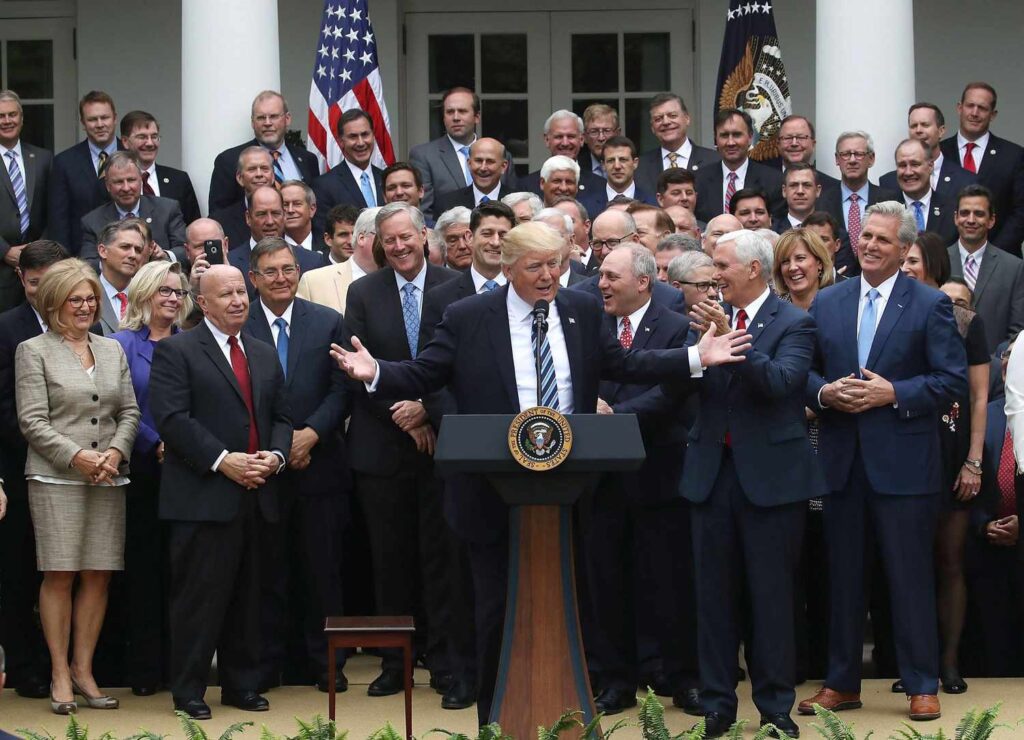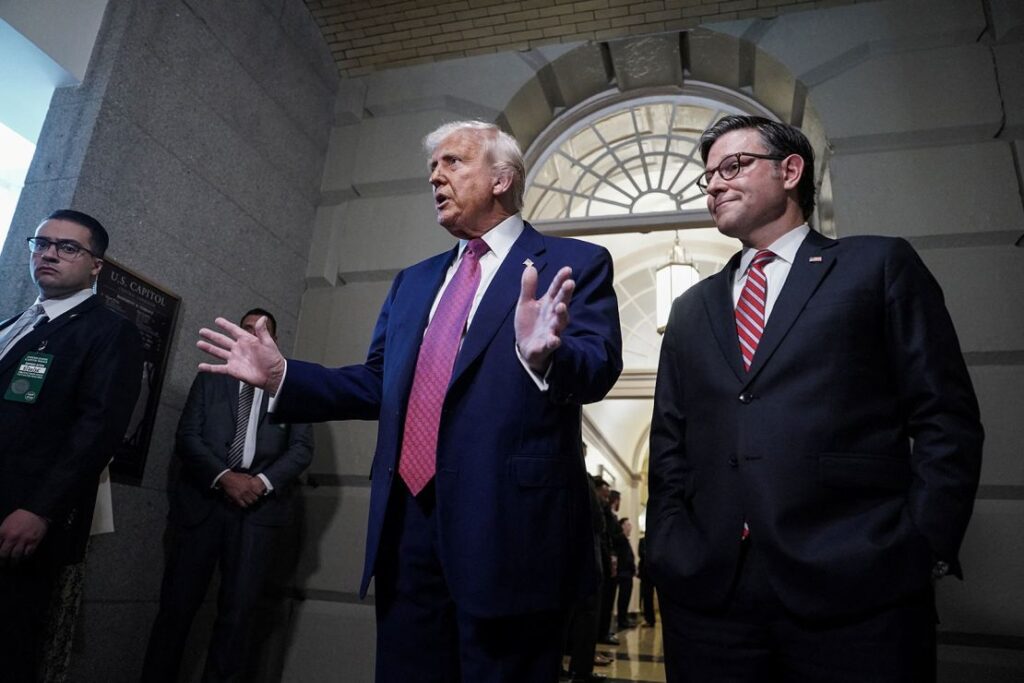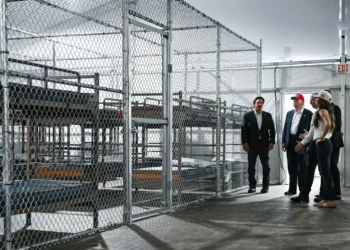A significant development has emerged in the U.S. political landscape with House Speaker Mike Johnson announcing a breakthrough on a major hurdle to the proposed $3 trillion budget proposal.
This budget deal is poised to include key components such as extended tax cuts from the 2017 era and adjustments to the SALT cap, alongside spending reductions. The agreement is seen as a crucial step forward for the administration’s economic policy.

The proposed deal aims to navigate the complexities of GOP infighting, a challenge that has often hindered significant legislative progress. With this development, the focus now shifts to the details and the potential impact on the U.S. economy.
Key Takeaways
- The proposed $3 trillion budget deal includes extended 2017-era tax cuts.
- Adjustments to the SALT cap are part of the compromise.
- Spending reductions are a key component of the deal.
- House Speaker Mike Johnson has announced a breakthrough on the budget proposal.
- The deal aims to navigate GOP infighting and push forward the administration’s economic agenda.



The $3 Trillion Budget Deal: An Overview
A significant development in the budget negotiations, the $3 trillion deal announced by Speaker Johnson, is set to reshape fiscal policies. This comprehensive budget package includes several key components that are expected to have far-reaching implications.
Speaker Johnson’s Announcement of the Agreement
Speaker Johnson’s announcement of the $3 trillion budget deal marked a crucial milestone in the negotiations. The agreement is a result of extensive discussions and compromises among lawmakers.
Key Obstacles Overcome
The path to this agreement was not without its challenges. Lawmakers had to overcome significant hurdles, including disagreements over tax cuts and spending reductions. The SALT deduction cap adjustment was one of the contentious issues that was eventually resolved.
Timeline for Congressional Vote
The budget deal is now poised for a congressional vote. The timeline for this vote is critical, as it will determine the fate of the proposed budget. According to sources, the vote is expected to take place within the next few weeks.
“This budget deal represents a major step forward in our efforts to stimulate economic growth and provide relief to American families,” said Speaker Johnson during the announcement.
Core Components of the Budget Package
The $3 trillion budget deal encompasses several core components, including extended Trump-era tax cuts from 2017, adjustments to the SALT deduction cap, and spending reduction measures. These elements are designed to work together to achieve fiscal balance and promote economic growth.
| Component | Description | Impact |
|---|---|---|
| Extended Trump-Era Tax Cuts | Continuation of tax cuts implemented in 2017 | Stimulate economic growth |
| SALT Deduction Cap Adjustment | Raising the cap to $40,000 | Relief for high-tax states |
| Spending Reduction Measures | Cuts in various government programs | Reduce fiscal deficit |
Trump’s 2025 Budget Bill: $3 Trillion Proposal Under Mike Johnson’s House Speaker Leadership
Under the leadership of Mike Johnson as House Speaker, Trump’s 2025 budget bill proposes a $3 trillion package that extends previous tax cuts and introduces new spending reduction measures. This comprehensive budget plan is a significant development in the ongoing 2025 federal budget negotiations.

Extended Trump-Era Tax Cuts from 2017
The bill includes the extension of the existing income tax cuts that were initially approved during Trump’s first term in 2017. These tax cuts are a cornerstone of Trump’s economic policy and are expected to continue influencing the economy in 2025.
- Continuation of the 2017 tax reform
- New tax cuts campaigned for in 2024
- Potential adjustments to tax brackets
Spending Reduction Measures
In addition to tax cuts, the budget proposal includes significant spending reduction measures aimed at reducing the federal expenditure. These measures are crucial for balancing the budget and ensuring fiscal responsibility.
- Review of existing federal programs for potential cuts
- Reductions in non-essential government spending
- Reallocation of funds to priority areas
Timeline for Implementation
The implementation of the budget bill is slated to follow a specific timeline, with clear priorities for the first 100 days and a long-term budget roadmap.
First 100 Days Priorities
The initial phase will focus on quick implementation of key budget items, including the extension of tax cuts and initial spending reductions.
- Passage of the budget bill
- Initial spending cuts
- Implementation of new tax policies



Long-term Budget Roadmap
Beyond the first 100 days, the budget proposal outlines a long-term roadmap for fiscal management, including ongoing review and adjustment of spending and tax policies.
The long-term roadmap is crucial for sustained economic growth and fiscal stability.
The SALT Compromise: A Major Breakthrough
A significant breakthrough in the 2025 Republican budget deal is the proposed SALT compromise. This compromise is a critical component of Trump’s $3 trillion budget proposal, aiming to address the concerns of high-tax state residents and suburban homeowners.
Raising the SALT Deduction Cap to $40,000
The bill proposes to raise the current $10,000 cap on the state and local tax (SALT) deduction to $30,000 for joint filers with incomes up to $400,000 a year. This adjustment is expected to provide significant relief to taxpayers in high-tax states.
Income Limitations and Eligibility
The SALT deduction cap increase comes with income limitations. Joint filers with incomes exceeding $400,000 will not be eligible for the increased deduction cap. This measure aims to target the relief towards middle-class families.
Impact on High-Tax States
High-tax states, particularly those with significant suburban populations, are expected to benefit from the SALT compromise. The increased deduction cap will help mitigate the tax burden on residents in states like New York, New Jersey, and California.
Benefits for Suburban Homeowners
Suburban homeowners in high-tax states will be among the primary beneficiaries of the SALT compromise. The increased deduction cap will lead to:
- Reduced tax liabilities
- Increased disposable income
- Enhanced economic activity in local communities
State-by-State Analysis
A state-by-state analysis reveals that the SALT compromise will have varying impacts across different regions. States with higher state and local taxes will benefit more from the increased deduction cap.
Tax Relief Measures for American Families
As part of Trump’s 2025 budget bill, several tax relief provisions are designed to ease the financial burden on middle-class families. The proposed measures aim to support American families through a combination of tax cuts and enhanced credits.
Extensions to the Standard Deduction
The budget deal includes an extension to the standard deduction, which has been bolstered to $32,000 for joint filers. This change is expected to provide significant relief to middle-income earners by reducing their taxable income.
Enhanced Child Tax Credit Provisions
A notable provision in the budget is a temporary $500 boost to the child tax credit. This enhancement is intended to support families with children by providing them with additional financial resources.
Income Tax Cut Extensions
The budget package also includes extensions to income tax cuts, continuing the trend of reducing the tax burden on individuals and families. These cuts are designed to stimulate economic growth by increasing disposable income.
Middle-Class Impact Assessment
The impact of these tax relief measures on the middle class is expected to be positive, with many families likely to see a reduction in their tax liability. The combined effect of the extended standard deduction, enhanced child tax credit, and income tax cuts could lead to increased financial stability for middle-class households.
Some of the key benefits for middle-class families include:
- Increased financial savings due to reduced tax liability
- Enhanced child tax credits providing additional support for families
- A bolstered standard deduction reducing taxable income
The tax relief measures outlined in the budget deal are a significant step towards supporting American families. By extending and enhancing various tax cuts and credits, the proposal aims to ease the financial strain on middle-class households and promote economic growth.
Proposed Spending Cuts and Program Reductions
Proposed spending cuts and program reductions are set to reshape the federal budget landscape. The $3 Trillion Budget Deal includes several key areas where reductions are proposed, impacting various government programs and services.
Medicaid Funding Changes
The budget proposal includes significant changes to Medicaid funding, shifting towards a block grant model for states. This change could have far-reaching implications for Medicaid beneficiaries and healthcare providers.
State Block Grant Proposals
Under the proposed block grant system, states would receive a fixed amount of funding for Medicaid, giving them more flexibility in program administration. However, this could lead to disparities in healthcare access across different states.
Coverage Impact Projections
Analysts project that the block grant model could result in reduced coverage for certain populations, particularly in states with higher Medicaid enrollment rates. “The impact on vulnerable populations could be significant,” notes a recent health policy report.
Clean Energy Tax Credit Reductions
The budget deal also proposes reductions in clean energy tax credits, which were expanded under the Inflation Reduction Act. This move is expected to affect investment in renewable energy projects and the overall transition to cleaner energy sources.
Other Program Cuts and Fiscal Adjustments
In addition to Medicaid and clean energy tax credits, other government programs are slated for reductions. These cuts are part of a broader effort to reduce government spending and adjust fiscal priorities. Key areas affected include education, infrastructure, and social welfare programs.

As the budget proposal moves forward, these spending cuts and program reductions will be closely scrutinized by lawmakers and stakeholders. The final outcome will depend on negotiations and the ability to balance competing fiscal and social priorities.
House Freedom Caucus Opposition and GOP Infighting
The House Freedom Caucus is gearing up to oppose the $3 Trillion Budget Deal, sparking GOP infighting. This opposition is rooted in the caucus’s concerns about the budget’s impact on fiscal conservatism and the potential for increased spending.
Fiscal Conservative Criticisms
Fiscal conservatives within the House Freedom Caucus are criticizing the budget deal for not adequately addressing spending cuts. They argue that the proposed tax cuts and increased SALT deduction cap will not be sufficiently offset by the spending reductions.
Key Concerns:
- Insufficient spending cuts to offset tax reductions
- Potential increase in national debt
- Lack of significant reforms in entitlement programs
Representatives Harris and Norman’s Concerns
Representatives Harris and Norman have expressed specific concerns regarding the budget deal. They are worried about the implications of the SALT deduction cap increase and the potential impact on high-tax states.
Growing Tensions Within the Republican Party
The opposition from the House Freedom Caucus is contributing to growing tensions within the Republican Party. The debate over the budget deal is highlighting deep divisions between moderate Republicans and fiscal conservatives.
Potential Voting Blocs
The voting dynamics on the budget deal are complex, with potential voting blocs forming along ideological lines. The table below illustrates the possible voting patterns:
| Voting Bloc | Key Issues | Likely Vote |
|---|---|---|
| House Freedom Caucus | Spending cuts, tax reforms | Opposed |
| Moderate Republicans | SALT deduction cap, tax cuts | In Favor |
| Fiscal Conservatives | National debt, entitlement reforms | Opposed |
The outcome of the vote remains uncertain, with the potential for significant amendments as the bill navigates through Congress.
Trump’s Congressional Visit: Rallying GOP Support
Trump’s appearance before Congress was aimed at drumming up support among GOP lawmakers for his $3 trillion budget deal.
During the visit, Trump emphasized his campaign promises, including tax cuts and a compromise on the State and Local Tax (SALT) deduction cap. He highlighted the potential benefits of his budget proposal for American families and the economy.
Key Messages During the Capitol Hill Meeting
Trump’s key messages focused on the economic growth potential of his budget plan, including extensions to tax cuts and relief measures for families. He also addressed concerns regarding spending reductions and program cuts.
“We’re going to make America great again, and we’re going to do it with a budget that benefits everyone,” Trump said during the meeting.
Republican Lawmakers’ Responses
Republican lawmakers had mixed reactions to Trump’s visit. Some were supportive of his budget proposal, while others expressed concerns about the fiscal implications and potential opposition from within the party.
| Lawmaker | Response |
|---|---|
| Rep. Harris | Expressed concerns about the budget’s impact on national debt. |
| Rep. Norman | Supported the SALT deduction compromise. |
Strategy for Securing Votes
To secure votes, Trump’s team employed a strategy that included highlighting the benefits of the budget deal for key constituencies and negotiating with lawmakers to address their concerns.

The visit marked a significant effort by Trump to build support for his budget proposal within the GOP.
Economic Implications of the Budget Deal
As the $3 trillion budget deal unfolds, its economic implications are becoming increasingly clear, with treasury yields spiking due to anticipated debt issuance.
Treasury Yield Spikes and Market Reactions
The announcement of the budget deal has led to a significant increase in treasury yields, driven by concerns over the potential for increased debt issuance. This spike in yields reflects market reactions to the anticipated us fiscal deficit in 2025, which is expected to widen due to the proposed spending measures.
Investors are adjusting their strategies in response to the changing economic landscape, with some expressing concerns about the potential impact on long-term interest rates.
Moody’s Credit Rating Downgrade
In response to the budget proposal, Moody’s downgraded the US credit rating, citing concerns over the growing deficit and the potential for moody’s us credit rating downgrade to have far-reaching implications for the economy.
Long-term Sovereign Debt Concerns
The downgrade highlights the ongoing concerns about the US’s ability to manage its sovereign debt, with some analysts warning of potential long-term risks to the economy.
Economic Growth Projections
Despite the challenges posed by the budget deal, some economists remain optimistic about economic growth projections, citing the potential for increased government spending to stimulate economic activity.
| Economic Indicator | 2025 Projection | Long-term Impact |
|---|---|---|
| Treasury Yields | Increase by 1% | Higher borrowing costs |
| GDP Growth | 2.5% | Moderate expansion |
| Inflation Rate | 2.2% | Stable prices |
The Debt Impact: Fiscal Analysis and Projections
A recent analysis by the Committee for a Responsible Federal Budget has raised alarms about the fiscal implications of the new budget proposal.
The committee estimates that the proposed $3 trillion budget deal could lead to a $3.3 trillion increase in the national debt over the next decade. This significant rise in debt is attributed to various factors, including extended tax cuts and increased spending measures.
$3.3 Trillion Estimate
The Committee for a Responsible Federal Budget’s estimate highlights the potential long-term fiscal implications of the budget proposal. Key factors contributing to this estimate include:
- Extended Trump-Era tax cuts
- Increased government spending
- Potential reductions in revenue due to changes in tax policies
Decade-Long Fiscal Implications
The decade-long fiscal implications of the budget deal are significant, with potential impacts on the national debt and economic growth. A detailed analysis reveals that the budget proposal could result in:
- Increased borrowing costs
- Reduced government revenue
- Potential downgrades in credit ratings
Comparison to Previous Proposals
Compared to previous budget proposals, the current deal stands out due to its comprehensive approach to tax reform and spending adjustments. However, the fiscal implications are more pronounced, warranting careful consideration.
The analysis by the Committee for a Responsible Federal Budget serves as a critical reminder of the need for prudent fiscal management. As the budget deal moves forward, it is essential to weigh its potential impacts on the national debt and overall economic health.
Political Stakes and 2025 Implementation Challenges
The path to enacting the 2025 budget is fraught with challenges, including slim congressional majorities and potential legal hurdles. As the budget deal navigates through Congress, the dynamics of the congressional majority will play a crucial role in determining its success.
Congressional Majority Dynamics
The current congressional majority is slim, which could lead to difficulties in passing the budget bill. Negotiations and compromises will be essential to garner enough support. The dynamics within the Republican Party, including potential dissent from conservative factions, will also impact the bill’s progression.
Potential Legal and Procedural Hurdles
Legal challenges and procedural hurdles could further complicate the implementation of the budget deal. Potential lawsuits and disputes over the bill’s constitutionality may arise, potentially delaying or altering the implementation timeline.
State-Level Implementation Concerns
State-level implementation concerns are another significant challenge. Different states have varying levels of readiness and willingness to comply with the new budget provisions. Coordination between federal and state authorities will be crucial.
Federal-State Coordination Requirements
Effective implementation will require robust federal-state coordination. This includes aligning state policies with federal guidelines and ensuring that necessary resources are allocated. The success of the budget deal will depend on the ability of federal and state authorities to work together seamlessly.
The challenges associated with implementing the 2025 budget deal are multifaceted, involving congressional dynamics, legal hurdles, and state-level concerns. Addressing these challenges will be crucial to the success of the budget.
Conclusion: The Path Forward for Trump’s Budget Agenda
The Trump2025 budget bill represents a significant legislative priority for the administration, outlining a comprehensive economic policy framework. The $3 trillion budget deal encompasses key components, including extended Trump-era tax cuts, a SALT compromise, and spending reduction measures.
As the bill navigates through Congress, it faces challenges from the House Freedom Caucus and potential procedural hurdles. Trump’s congressional visit aimed to rally GOP support, but the path forward remains uncertain. The economic implications of the budget deal are far-reaching, with potential impacts on treasury yields, credit ratings, and economic growth projections.
The trump economic policy, as outlined in the budget, seeks to stimulate growth while addressing fiscal concerns. As the budget agenda moves forward, its success will depend on securing a congressional majority and addressing state-level implementation concerns. The outcome will be crucial in shaping the US economy and Trump’s economic legacy.
FAQ
What is the main proposal of Trump’s $3 trillion budget deal?
The main proposal includes extending Trump-era tax cuts, a SALT deduction cap compromise, and various spending reduction measures.
How does the SALT compromise affect high-tax states?
The SALT compromise proposes raising the SALT deduction cap to $40,000, which is expected to benefit high-tax states by allowing more residents to deduct state and local taxes.
What are the implications of the proposed spending cuts?
The proposed spending cuts include changes to Medicaid funding, reductions in clean energy tax credits, and other fiscal adjustments, which could impact various programs and the populations they serve.
How does the budget deal impact American families?
The budget deal includes tax relief measures such as extensions to the standard deduction, enhanced child tax credit provisions, and income tax cut extensions, aimed at benefiting American families.
What is the estimated debt impact of the budget deal?
According to the Committee for a Responsible Federal Budget, the budget deal is estimated to increase the national debt by $3.3 trillion.
What are the potential challenges to implementing the 2025 budget deal?
Potential challenges include congressional majority dynamics, potential legal and procedural hurdles, and state-level implementation concerns.
How did Trump’s congressional visit impact the budget bill’s passage?
Trump’s congressional visit aimed to rally GOP support, with key messages delivered during the meeting and a strategy employed to secure votes for the budget bill.
What are the economic implications of the budget deal?
The budget deal’s economic implications include treasury yield spikes, market reactions, and a Moody’s credit rating downgrade, with potential long-term sovereign debt concerns and economic growth projections.
How does the House Freedom Caucus oppose the budget deal?
The House Freedom Caucus opposes the budget deal due to concerns over fiscal conservatism, with criticisms from Representatives Harris and Norman, and growing tensions within the Republican Party.
What is the timeline for implementing Trump’s 2025 budget bill?
The timeline includes priorities for the first 100 days and a long-term budget roadmap, with the aim of implementing the budget deal in 2025 under Mike Johnson’s leadership.





















































